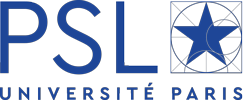Perseverance: An inside look at the Mars landing from two scientists at the Observatoire de Paris – PSL
On February 18, 2021, people around the world were able to forget about the pandemic for a few hours and gaze with fascination as the Perseverance rover landed on Mars. The new space rover, developed as part of the international Mars 2020 mission, will explore the depths of the Jezero crater and collect samples. One of the seven instruments operating on board the rover is SuperCam, for which France had joint responsibility. Teams of scientists from the Laboratory of Space Studies and Instrumentation in Astrophysics (LESIA) at the Observatoire de Paris – PSL played a critical role in its development. We talk with Pernelle Bernardi, a CNRS research engineer at LESIA and systems engineer for the SuperCam camera, and Athéna Coustenis, astrophysicist and director of CNRS research at LESIA.
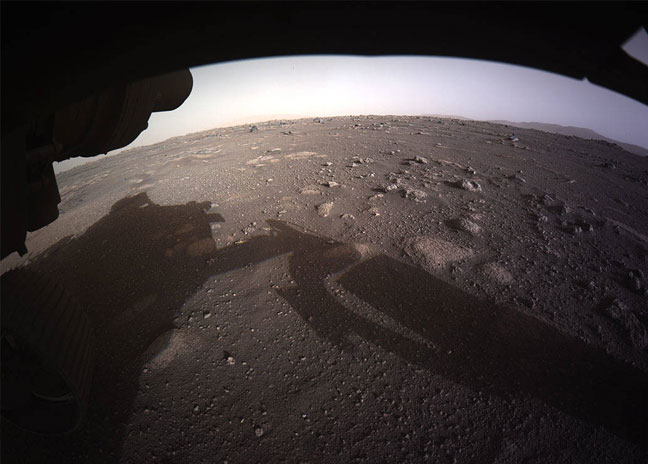
PSL: People around the world watched the video of Perseverance landing on Mars on March 22. Could you give us your scientific perspective on that amazing landing? What were some of the key moments? Were there moments when you were nervous or fearful on behalf of the rover?
I was panicking and holding my breath during those seven minutes! The entire sequence was automated: there was no way we could intervene. All we could do was watch.
Pernelle Bernardi: Landing a more than one-ton robot on Mars is probably the most complex technical challenge in space exploration today. You have to successfully shut off the initial speed supplied by the powerful U.S.-made Atlas V rocket. Every step in the landing procedure is critical and must succeed; otherwise the mission is a failure. For the Jet Propulsion Laboratory, which built the mission, the opening of the parachute at hypersonic speeds (more than 1,500 km/hour) is the most sensitive part of the operation. I was panicking and holding my breath during those seven minutes! The entire sequence was automated: there was no way we could intervene. All we could do was watch. And then you have to remember that by the time the signal indicating entry into the Mars atmosphere arrived on Earth, the rover had already landed four minutes earlier (it takes 11 minutes for data to travel the distance between the two planets). After seeing the images of the descent, you have to be impressed by the absolute engineering wizardry of the JPL: the pictures are simply mind-boggling. And they took the liberty of adding an Easter egg on the parachute that spells out the JPL’s motto, “Dare mighty things.” They’re really justified in dreaming their wildest dreams!
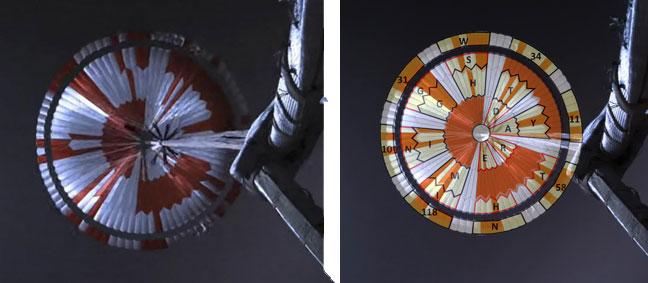
Athéna Coustenis: “Wildest dreams” is right! When you’re a scientist, every opportunity to witness a landing (or a takeoff) is a gift, an incredible moment that opens up a new chance to learn more, enhance your knowledge and marvel over the future discoveries in store. I’ve been fortunate to watch three launches (Cassini to Saturn in 1995, Horizon to the ISS in 2018 and the Solar Orbiter to the sun in 2020) along with several “arrivals” (Voyager 2 at Neptune in 1989, Cassini in 2004 and Perseverance). Every time it’s been a magical and terrifying moment, since there’s always the risk of failure. For a landing, versus a launch into orbit, it’s even more exciting. Mars is a special case. It’s been a primary attraction for space exploration; a large number of missions have been sent to Mars since the 1960s, and we’ve seen a lot of setbacks. It’s been a difficult undertaking.
Every mission that lands on the surface of Mars is a feat. This time, with SuperCam on Perseverance, we in France were on center stage. As a result, we felt the anxiety and exhilaration that precedes the landing even more intensely than usual.
I had my own “several minutes of terror” experience alongside my colleagues at the Cité des Sciences et de l’Industrie. We followed the event live and provided commentary to an audience tuning in about the mission’s scientific benefits, including a better understanding of a world that has so much to teach us about climate, atmospheric change, the emergence of life and habitability in general. The criteria for habitability are liquid water, organic compounds and sources of energy in a stable environment.
PSL: In your view, how exactly does the Mars 2020 mission differ from previous missions?
Mars 2020 will enable us to analyze data that provides a fuller understanding of, among other things, how the planet lost its atmosphere.
Athéna Coustenis: Previous missions, such as the European Mars Express probe and NASA’s Mars Reconnaissance Orbiter, showed numerous signs of erosion on the Mars surface, including indications of rivers and major flooding. So we have proof that large quantities of liquid water were present on Mars about 3.5 billion years ago. But that phenomenon may have been very brief and it happened a very long time ago. Mars 2020 will enable us to analyze data that provides a fuller understanding of, among other things, how the planet lost its atmosphere. Our thinking is that, without plate tectonics, Mars has been unable to recycle carbon dioxide from rocks into the atmosphere, and as a result it can’t maintain a significant greenhouse gas effect. That’s resulted in very low temperatures (-60°C) and the loss of its atmosphere, probably because of solar wind and radiation, since there’s no magnetic field to provide protection.
This new NASA mission, coupled with the other active missions on and around Mars (recently including the Hope mission from the United Arab Emirates and China’s Tianwen-1), will provide us with data that we can study in order to reconstruct the history of water activity on Mars and characterize an ancient period when the environment might have favored the emergence of a prebiotic chemistry. With that in mind, three of the missions that are currently active (Mars Express, Curiosity and the ExoMars Trace Gas Orbiter) have measured the quantity of methane in the Martian atmosphere and they each produced different results, either detecting methane or finding none in the upper atmosphere. So the question was then raised as to whether methane was really a possible sign of some form of life. On Earth, methane is 90% related to life; it’s a byproduct of the metabolism of living organisms. We still have to confirm and explain the presence of methane on Mars, but it could be tied to volcanic or hydrothermal activity, and possibly we can’t detect it because of heterogeneous chemistry that destroyed it. It’s too early to say, and in general we’re faced with the problem of interpreting measurements made by different instruments in the presence of other atmospheric gases, but let’s hope this mission will provide some answers to our questions.
PSL: SuperCam is described as the rover’s head and eye. Can you explain what that means? What’s distinctive about the camera?
The equipment built into Super Cam is a first in many respects and a real technological achievement.
Pernelle Bernardi: Basically, SuperCam is the instrument on top of the mast (the head) and it’s equipped with a camera (the eye). But first and foremost it’s a French-American instrument consisting of two units:
- the Mast Unit, supplied by France, which sits atop the Perseverance mast. Its telescope is 110 millimeters in diameter and forms the rover’s eye.
- the Body Unit, which is hidden in the rover’s body, was provided by the Los Alamos National Laboratory (LANL) in New Mexico, in the U.S.
SuperCam is also often referred to as Perseverance’s Swiss army knife, because it’s a single instrument equipped with five different remote observation techniques: three spectroscopy techniques for studying rock chemistry (LIBS) and mineralogy (Raman-Luminescence and visible infrared reflectance), plus a color imager and a microphone for recording Martian winds and shockwaves emitted by the LIBS plasma. Those features are a first in many respects and a real technological achievement. None of the instruments on previous missions were equipped with, say, a functional mic, or Raman spectroscopy with shooting functions. As Athéna said, it’s a big source of pride to have been able to contribute to this project. SuperCam will play a strategic role in deciding what targets to study and choosing sites for taking samples.
PSL: SuperCam was developed by a scientific consortium that included both French and international laboratories. How did that collaboration proceed (how long was it, how many people were involved, etc)? What was LESIA’s role in particular?
There were more than 200 people involved in designing, manufacturing, integrating and testing the mast unit over a six-year period, not to mention the many industrial partners involved.
Pernelle Bernardi: Yes, this project is an excellent example of how an international scientific consortium works. SuperCam is the product of a long-standing collaboration between the LANL and the IRAP in Toulouse that had earlier produced the ChemCam used on Curiosity. The French part of the instrument, the mast unit, was developed under the supervision of the French National Centre for Space Studies (CNES) by a consortium of six CNRS and university laboratories, including LESIA at the Observatoire de Paris – PSL. There were more than 200 people involved in designing, manufacturing, integrating and testing the mast unit over a six-year period, not to mention the many industrial partners involved. That required a great deal of organization and an ongoing dialogue among the French partners but also with the LANL and the JPL. LESIA played a major role in the consortium by taking on key project oversight responsibilities (jointly managing the project, responsibility for systems, the thermal architecture and so on) as well as by delivering the infrared spectrometer we developed jointly with the LATMOS space laboratory and being part of the scientific team. In addition, the final series of tests on the mast unit before it was mounted on the rover was conducted in LESIA’s clean rooms at the Observatoire de Paris – PSL facility in Meudon.
Athéna Coustenis: Just to add to what Pernelle said, I’d like to situate Perseverance against the backdrop of the Mars Sample Return (MSR) project. Perseverance is the first milestone in that joint project between NASA and the European Space Agency. Its mission of gathering and storing samples for future analysis on Earth is part of a fairly complex scenario that wouldn’t be possible without that close cooperation between the two space agencies. Europe is playing an essential role in obtaining those samples and managing their return to Earth via the Earth Return Orbiter (ERO). In this type of project, Europe is fortunate to be a preferred partner for NASA and Roscosmos, the Russian space agency, and as a result European engineers and scientists are at the forefront of activity not only for current space missions but future missions as well.
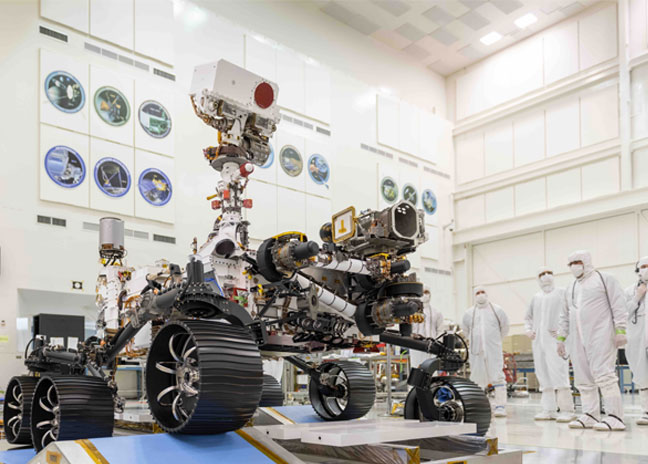
PSL: Perseverance has begun its work of exploration and collection and the first samples are expected in 2031. How do you verify from Earth that the equipment is functioning properly? What responsibilities do the teams from LESIA have?
A team of engineers and researchers meets at the CNES operations center every day to receive and analyze data from the previous day and prepare a plan of activities for the following day.
Pernelle Bernardi: Perseverance has just arrived on the Martian surface and the process of verifying that the vehicle and its instruments are working properly is now in full swing. To operate SuperCam, a team of engineers and researchers meets at the CNES operations center (FOCSE) every day to receive and analyze data from the previous day and prepare a plan of activities for the following day. They analyze the spectra, the sound files, the images, and offer their scientific interpretation, which they forward to the geology and chemistry teams. Their role is to acquire as much data as possible with SuperCam while ensuring that they’re using it as safely as possible.
LESIA is actively participating in those efforts by providing instrument technical expertise and making a scientific contribution to both uplink (by preparing observation sequences) and downlink (by analyzing data), as well as helping with medium and long-term strategies. Those operations are being defined for the next three years, and may even go on for five years.
For the technical teams that developed the instruments, including myself, the rover’s landing marks the end of a phase in our professional lives. But for the scientists it’s just the start of the adventure. This mission will yield exceptional material for scientific exploration. It’s opening up new topics for research. Two postdoctoral fellows have already begun work at LESIA and we’re immensely fortunate to be able to draw on the French scientists involved in the various teams analyzing samples from the rover. The prospects opening up are immense.
Athéna Coustenis: Exactly, the adventure is just starting! Today, Mars is a cold, inhospitable desert, but characteristics such as dried-up riverbeds and minerals that only form with liquid water suggest that a long time ago, Mars had a thick atmosphere that retained enough heat for liquid water to flow on the surface.
However, questions remain, especially about the specific conditions in the past. What happened to the water that used to flow on Mars? At what point was the Martian environment similar to that on Earth? And for how long?
If life might have emerged, could we find traces of fossil life? Where did the methane come from?
And a lot of effort is being devoted to future exploration of the planet to answer those questions. Perseverance and the entire Mars Sample Return project, for which Mars 2020 is just the first step, will play a critical role.
We should emphasize that gathering and handling the samples that arrive on Earth is no simple task. In addition to the technological prowess required, we need to be careful not to contaminate the environment in which we do the collecting and also ensure we don’t contaminate the Earth. That’s what’s known as “planetary protection.” The samples will be brought back to Earth for analysis by scientists in specialized facilities, and they’ll advance our knowledge about the red planet and our search for life in the solar system. All of that needs to be carried out in strict accordance with planetary protection rules so as not to contaminate Mars, on one hand, but also prevent any risks to our own biosphere from the returned samples. I chair a COSPAR committee whose members include other French scientists and representatives from the CNES, and we’ll be ensuring compliance with those rules.
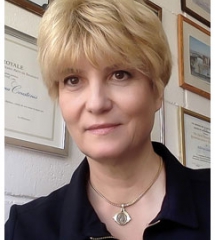
Athéna Coustenis is a French astrophysicist who specializes in planetology. She is Director of Research for France’s National Centre of Scientific Research (CNRS) at LESIA (Laboratory of Space Studies and Instrumentation in Astrophysics) at the Observatoire de Paris – PSL. She participates in and directs space missions for the European Space Agency (ESA) and NASA. She focuses primarily on the gas giants: Saturn, Jupiter and their moons. She chairs advisory committees at the ESA, the CNES and the Committee on Space Research (COSPAR).
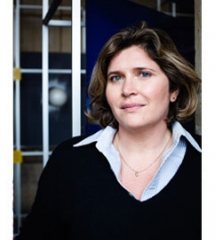
Pernelle Bernardi is a CNRS research engineer in astrophysics at LESIA (Laboratory of Space Studies and Instrumentation in Astrophysics) at the Observatoire de Paris – PSL. Specializing in the development of instruments for space exploration or for installation on large ground-based telescopes, she was in charge of the specifications and performance of SuperCam. In 2020 she was the recipient of the CNRS Crystal Medal.
Read her interview in CNRS News
Landing of the Perseverance rover on Mars: February 18, 2021
First samples collected: starting in 2031
Lecture: Objectives, assessment and first results of the SuperCam instrument on board the Perseverance rover
March 16 - 11 a.m.
